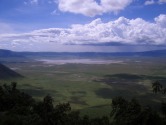TANZANIA TANZANIA NGORONGORO CONSERVATION AREA
Ngorongoro Conservation Area
The Ngorongoro Crater is East Africa’s ultimate ’Big Five’ destination. Heavy-tusked elephant bulls haunt its groves and swamps, while a precious herd of black rhino is regularly seen in more open terrain, and dense populations of lion, leopard and other predators gorge on abundant herds of buffalo and other grazers. The relatively high traffic density within the crater is a downer for some, but the wildlife is exceptionally habituated as a result, allowing for a rare opportunity to observe unselfconscious animal behaviour at close range.
Even without the wildlife, this crater at the heart of the Ngorongoro Conservation Area (NCA) would rank among Africa’s most compelling scenic attractions. The relic of an extinct volcano which once stood taller than Kilimanjaro does today, this is the world’s largest intact caldera, and the view from the forested rim, across 260km2 of enclosed savannah, defies superlatives.
Vegetation and habitats
- Like the Serengeti, much of the crater floor consists of dusty cropped plains. Landmarks within the crater include Lerai fever-tree forest, the shallow, saline Lake Magadi, and the freshwater Gorigor Swamp.
- Reaching an altitude of 2,417m, the crater rim supports Afro-montane forest similar to that found on Kilimanjaro.
- The rest of the NCA can be split into two broad eco-zones. The well-watered, grassy Ngorongoro Highlands rise to 3,600m in the east, while the low-lying western plains around Olduvai Gorge are an ecological extension of southern Serengeti.
Wildlife
- The crater floor supports Africa’s densest lion and spotted hyena populations. Cheetah, once uncommon, are now resident, but leopard are more common on the forested rim.
- This is an excellent place to see black rhino – although the population numbers fewer than 20, they often graze openly throughout the day.
- Giraffe and impala are absent from the crater floor, but the forests and marshes form something of a retirement home for male elephants, and there’s no better place to see serious tuskers!
- Lake Magadi often supports large numbers of flamingo (preyed on diurnally by hyenas) while Gorigor Swamp is popular with hippos and scavenging kites – the latter will readily swoop down to snatch a sandwich out of an unsuspecting picnicker’s hand!
- Ostrich, kori bustard and crowned crane are among the more conspicuous ground birds, while raptors include the handsome auger buzzard, foppish long-crested eagle, and Egyptian vulture.
Activities
- The main activity is game drives in the crater. Visits are limited to a half-day only, so it’s worth heading down with a packed breakfast before the masses descend.
- Maasai-led walks on the crater rim come with a fair chance of seeing large mammals and plenty of birds.
- Unlike Ngorongoro Crater, the remote Olmoti and Empakaai Craters in the north of the NCA are visited by few tourists and their scenic environs can be explored on foot with a guide.
- Olduvai Gorge, en route to the Serengeti, is where the Leakeys unearthed several important fossils; today it houses a worthwhile museum and a picnic site teeming with birdlife.
Getting there
- The crater can be visited at any time, since most of the wildlife is resident.
- Most people visit Ngorongoro as part of a longer 4x4 Serengeti safari out of Arusha, but the new surfaced road to the entrance gate means it could be done as day trip with an early start.
- A possibility for budget travellers would be to bus to nearby Karatu, which has plenty of cheap accommodation, and visit the carter as a day trip from there.
Where to stay
- It is forbidden to stay overnight in the crater, but four upmarket lodges on the forested rim offer superb views over the floor.
- Cheaper options include a chilly public campsite on the crater rim, and various local guesthouses in Karatu on the road back towards Arusha.
Nearby places of interest
- Easily visited as a day or overnight trip from Karatu, Lake Eyasi, evocatively barren with its Rift Valley setting, is home to the Hadza, sole remaining practitioners of the hunter-gatherer lifestyle that predominated in Tanzania until 2000 years ago.
Checklist of conspicuous and noteworthy mammals: lion, leopard, cheetah, spotted hyena, golden jackal, black-backed jackal, bat-eared fox, banded mongoose, blue wildebeest, Coke’s hartebeest, topi, Defassa waterbuck, Thomson’s gazelle, Grant’s gazelle, eland, bushbuck, African elephant, African buffalo, black rhinoceros, common zebra, hippo, warthog, Maasai giraffe, olive baboon, vervet monkey, tree hyrax.












